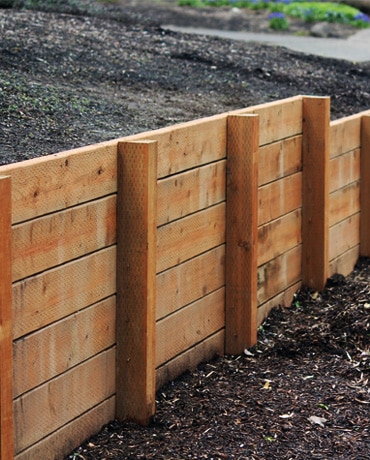Making Sure Architectural Stability: The Importance of Correctly Built Maintaining Wall Surfaces in Stopping Incline Failing
In the world of civil engineering and construction, the value of appropriately constructed retaining wall surfaces in preventing slope failure can not be underrated. By checking out the elaborate interaction between these elements, a much deeper comprehension of the pivotal duty that maintaining wall surfaces play in maintaining structural integrity and avoiding incline failure arises.
Role of Retaining Walls in Security
The necessity of retaining wall surfaces in making sure slope stability is paramount in civil engineering techniques. Preserving wall surfaces offer an important role in stopping dirt erosion, taking care of water runoff, and preserving the architectural integrity of slopes. By sustaining upright or near-vertical grade modifications, retaining walls aid to rearrange lateral stress put in by the soil, therefore reducing the danger of slope failing.
One trick function of keeping wall surfaces is to counteract the pressure of gravity acting upon the soil mass behind them. This is accomplished with correct layout and construction, which thinks about aspects such as dirt kind, wall surface height, drainage provisions, and prospective surcharge tons. By properly preserving dirt within defined borders, these frameworks help to support slopes and avoid landslides.
Additionally, maintaining wall surfaces add to the aesthetics of landscapes while providing functional benefits. They can create terraced levels for landscape design, assistance streets or frameworks on hillsides, and enhance the general use of sloped terrain. Fundamentally, keeping wall surfaces play a vital function in keeping slope security and ensuring the security and longevity of civil design projects.
Variables Affecting Wall Effectiveness
Aspects that affect the performance of retaining walls include soil properties, wall design, and outside tons. Appropriate wall surface layout takes into consideration factors like wall height, wall surface type (e.g., gravity walls, cantilever wall surfaces), support products, drain systems, and building methods to guarantee the wall can stand up to the lateral pressure exerted by the preserved soil. By considering these aspects thoroughly, designers can build keeping walls that efficiently protect against slope failing and ensure lasting structural honesty.
Style Factors To Consider for Maintaining Wall Surfaces
Integrating the vital aspects of soil homes and outside loads right into the architectural design procedure is essential for creating efficient keeping walls that ensure incline security. When creating maintaining walls, engineers should thoroughly assess the qualities of the surrounding soil, including its drainage, compaction, and kind residential or commercial properties. Comprehending these soil buildings is vital for figuring out the appropriate wall surface thickness, reinforcement, and height needed to hold up against the side stress put in by the dirt mass.
Furthermore, exterior lots such as additional charge loads from nearby frameworks or traffic, in addition to seismic pressures, should be taken into consideration during the style phase. These tons can significantly affect the security and performance of a maintaining wall surface, requiring using appropriate layout strategies and products to alleviate possible failing risks.
Furthermore, the choice of ideal products, such as concrete, rock, or timber, ought to line up with the site-specific problems and visual requirements. Variable of safety and security considerations, water drainage stipulations, and building methods are additionally essential aspects that influence the overall design and functionality of keeping walls in protecting against incline failing. By carefully considering these design factors to consider, designers can make certain the architectural honesty and long-term security of keeping wall surfaces.

Building Best Practices for Longevity
When constructing preserving wall surfaces for imp source optimal longevity and durability, adherence to industry-standard strategies and careful attention to information are paramount. To make certain the sturdiness of a retaining wall, correct site prep work is important.
Incorporating support techniques, such Get More Info as geogrids or steel bars, can improve the architectural stability of the retaining wall surface and avoid potential failures. By adhering to these construction finest techniques, maintaining wall surfaces can stand up to the test of time and effectively prevent incline failure.
Significance of Appropriate Maintenance
Regular upkeep is crucial for maintaining the architectural stability and functionality of keeping wall surfaces gradually. Ignoring maintenance can lead to issues such as disintegration, fractures, or even complete failing of the wall, jeopardizing the security of the incline it supports. To ensure that preserving wall surfaces continue to execute their designated function effectively, normal assessments should be performed to identify any kind of signs of damage. These assessments can help in spotting very early indication of prospective problems, permitting for timely fixings to be performed before the problems escalate (Retaining Walls Sunshine Coast).

Verdict
In conclusion, retaining walls play a vital duty in making certain architectural honesty and avoiding incline failure. By considering variables affecting wall surface effectiveness, sticking to make considerations, following building finest practices, and executing proper maintenance, the toughness of keeping walls can be made the most of. Retaining Walls Sunshine Coast. It is necessary to identify the value of appropriately constructed preserving wall surfaces in preserving stability and avoiding potential hazards connected with slope failure
Elements that influence the performance of maintaining walls consist of dirt properties, wall surface layout, and outside loads. Correct wall design takes into consideration variables like wall surface height, wall surface type (e.g., gravity wall surfaces, cantilever wall surfaces), reinforcement products, water drainage systems, and construction strategies to guarantee the wall surface can endure the side pressure exerted by the maintained dirt. By considering these factors adequately, engineers can create maintaining walls that properly stop slope failure and ensure long-lasting architectural stability.
Maintenance jobs may include getting rid of drain systems to protect against water accumulation behind the wall surface, repairing any type of visible splits or damage, and making sure that the wall is complimentary from plant life that might apply pressure on the framework. By considering elements affecting wall surface effectiveness, adhering to develop considerations, adhering to construction best methods, and applying proper maintenance, the toughness of maintaining wall surfaces can be optimized.